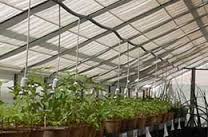The following information is to do with various types of shade houses, that I have found work very well on cattleya orchids. They are built with either galvanised pipe or weld mesh. The problem with wood is that it will rot long before the pipe or mesh will rust, also the price of good hardwood that is not treated, is getting too dear.
The attached drawings are a guide to shape, light, shade cloth density etc. All of my shade houses are built with galvanised water pipe, benches are water pipe frames, with weld mesh on the top. Downey pipe fittings are used to join the pipe together. Chicken galvanised wire (50mm) is used to cover the houses to support the shade cloth, especially when it hails. (Not required if built with weldmesh). Different shaped roofs give maximum light at various times of the day, which I will explain next to each drawing. Where ever possible, the shade house should be built NORTH to SOUTH, this allows the sun to cross over, giving the better light overall. The posts can be cemented into the ground, or anchor bolts can be cemented in the ground and attached to the posts. A cement border around the house with a strip of (50×50) weld mesh imbedded in it, to attach the wire and shade cloth too, saves a lot of problems. I have made my last lot of benches out of concrete Besser blocks, standing on end, with standard weldmesh fencing panels laying on top, with only the first bend on the sides bent, which acts as a stopper, for plants inclined to fall off the bench. The benches are lower than normal, but I have found it easier to reach plants, easier to see problems. With higher benches you are looking through the plants and can easily miss problems, also makes watering easier and benches can be moved because they are not fixed.
Floors can be a headache, my floors are first crusher dust, about 50/75 mm, then weed-mating, good quality, that’s all. You can cover the matting with small stones, sand etc., but remember where there is something to grow in, weeds will come. Another good idea are cement pathways, everlasting. Keep benches at least 1.3mtrs apart, this allows for room when the plants protrude over the side of the benches and it will take a wheelbarrow.
I have found that the best shade cloth colour is either BLACK or DARK GREEN. It gives the most accurate shade density that the makers claim. I use “MEDIUM” (70%) on all my cattleyas. I did try a combination of black and light green, but it let in too much light. The white and art shade colours are too bright, might look good, but can cause problems in summer, burnt leaves and flowers etc.
I join the shade cloth with shade cloth twine; it will last as long as the cloth. Secure the cloth to mesh imbedded in the concrete strip around the bottom of the walls, or fix timber to the base of the posts and fix cloth to it.
Remember to have wire netting under the top of the shade house, to stop hail damage. Seal the gap around the door to keep out grasshoppers etc.
Watering Systems
I have OVERHEAD and UNDERBENCH spray systems. The overhead are fogger-sprays, only used in summer, especially on very hot days. The under-bench are used to increase humidity. No fertilisers, fungicides or insecticides are put through either system, as they clog up the jets and not all plants receive the spray.
I hand water the plants, even after using over-head sprays, to make sure all plants are watered. All fertilisers, fungicides and insecticides are applied by hand, that way the underside of leaves is covered. Fungicides and insecticides should have a wetting agent added to them. Dish washing liquid will work ok.



